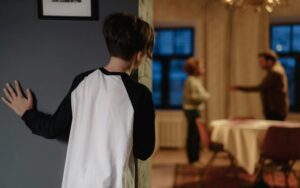“The Forgotten Canvas“
The attic was a tomb of forgotten things, a place where time had settled like dust on forgotten dreams. Lena hadn’t been here in years, but something had called her to it today, something unspoken but urgent, like a melody she could almost remember.
There, in the corner, was the easel—bent, abandoned, and fragile, like a ghost of a life she had left behind. Beside it, leaning against the wall, was a canvas. She reached for it with trembling hands, lifting it into the light.
And there it was: a painting unfinished, suspended in time. Half of it blazed with bold strokes—fiery oranges, deep blues—a sunset frozen in motion. The other half was empty, an untouched void that stared back at her like a question she hadn’t been brave enough to answer.
At twenty-one, Lena had believed her brushstrokes would shape the world. She remembered the evenings in her small studio, the quiet hum of music, the flicker of candlelight on canvases filled with hope. She had known then that she was meant for something more.
But life had its own plans. The quiet whispers of practicality from her parents turned into louder demands. “Be realistic,” they said, as if dreams were things to be handled with caution, like fragile glass.
The easel was folded and tucked away. Her brushes gathered dust. The blank canvas, like a mirror, stared back at her, mocking her.
Now, forty-six, Lena felt the weight of the years that had passed in a blur. The empty space on the canvas mirrored the void she carried inside. She traced the edge of the unfinished painting, fingers trembling as they skimmed over the colors that once burned with life.
But the regret was not just for what she hadn’t painted. It was for the girl who had once believed she could change everything, and the woman who had settled for something else, something safer, but infinitely smaller.
Her tears fell quietly, as if mourning both the past and the person she had never become.
She grabbed the easel, its wood cold in her hands, and carried it downstairs. She set it by the window, the light soft, forgiving. The paint tubes were cracked, their colors still waiting. She dipped her brush into the cobalt blue, and for the first time in years, she began.
Months later, the painting hung on her wall, unfinished but whole. The strokes were uneven, the colors bold yet hesitant, like someone learning to speak again.
But it was hers. Every stroke, every imperfection, was a truth she could finally hold.
Regret hadn’t vanished, but it had transformed. It was no longer a weight on her shoulders, but a bridge—a passage from who she had been, to who she was still becoming.
The canvas was not a monument to what had been lost, but a testament to what could still be found.
And for the first time in a long while, Lena allowed herself to believe that the masterpiece was never the point. It was the courage to keep painting, to keep becoming.
The Roads We’ll Never Walk
Somewhere in the vast corridors of our mind, there exists a gallery of moments we’ll never live. Faces we never met. Journeys we never took. Lives we’ll never call our own. Regret, often unspoken and quietly pervasive, lingers like a ghost, haunting the spaces between who we are and who we could have been.
We like to think we’re defined by what we do—the choices we make, the paths we follow. But just as powerfully, we’re shaped by the things we leave undone. The phone call we didn’t make. The risk we were too scared to take. These unlived lives press against the edges of our existence, whispering questions we can’t always answer.
The Anatomy of Regret: Why It Hurts So Much
Regret is not merely an emotion—it’s a mirror. It reflects back to us the fractures in our lives, the roads where we hesitated at the fork, the moments when fear outweighed courage. But why does it cut so deeply?
The Weight of “What Could Have Been”
Our minds are wired for possibility. We dream, we plan, we imagine futures that may never exist. This is the same gift that fuels creativity and hope, yet it’s also the root of our anguish. For every choice we make, countless others are left behind. And it is these discarded possibilities that weigh heaviest on our hearts.
The Quiet Tyranny of Inaction
Time erases many wounds, but the ache of what we didn’t do seems to linger. Over the years, our regrets of inaction—words unspoken, dreams deferred—grow louder. Why? Because the unrealized remains perfect in our minds, untouched by the flaws of reality. The life not lived becomes the life idealized, and nothing we do can measure up to its imagined perfection.
The Emotional Toll
Regret is not a single moment of pain; it’s a slow, lingering grief.
- The Ache of Unspoken Words
Think of the relationships we’ve lost, not through anger or betrayal, but through silence. The apology never given. The love never confessed. These regrets leave an emptiness, a hollow space where connection could have been. - The Trap of Rumination
Regret can trap us in a cycle of “what-ifs,” replaying moments we cannot change. This endless rumination isn’t just mentally exhausting; it’s a thief of the present. It blinds us to the life unfolding before us as we endlessly mourn the lives we left behind. - Regret as a Mirror of Our Values
Perhaps the most painful truth about regret is that it reveals what we truly care about. We don’t mourn every lost opportunity—only the ones tied to our deepest desires. The career path we didn’t pursue, the friend we didn’t fight to keep, the self we didn’t become.
The Paradox of Regret: Pain as a Guide
But here lies the paradox: regret, though painful, can also illuminate. It’s a reminder of our capacity to care, to dream, to reach for something more. What if, instead of burying it, we listened to it?
Reframing the Narrative
Regret is not proof of failure; it’s evidence of growth. The fact that you regret something means you’ve changed—your priorities have shifted, your understanding has deepened. Let that be a signpost, not a burden.
Turning Pain into Purpose
Every regret carries a lesson. Did you neglect a friendship you now long for? Let that regret teach you the importance of connection. Did you let fear hold you back? Use that memory to fuel your courage the next time.
Regret in a World of Infinite Comparison
In today’s hyper-connected world, the weight of regret is amplified. We’re constantly reminded of the lives we could have lived—the travels, the achievements, the perfect families, the dream jobs—all paraded before us on glowing screens. Social media doesn’t just show us what others have; it shows us what we lack.
But what we don’t see in these curated lives are the regrets hidden behind the filters. Everyone carries their own unlived lives, their own haunting “what-ifs.” The question isn’t whether we’ll have regrets—it’s what we’ll do with them.
Living with Regret: Finding Peace in Imperfection
Regret is inevitable, but it doesn’t have to be paralyzing.
- Acceptance as Liberation
You cannot live every life. You cannot take every path. There will always be things you miss, opportunities that slip through your fingers. Accepting this truth is not resignation—it’s freedom. - Choosing the Life You Have
Regret asks us to mourn the lives we didn’t live, but it also asks us to embrace the one we did. The paths we chose were not mistakes—they were acts of courage; decisions made with the wisdom we had at the time. - Healing Through Action
Where possible, turn regret into action. Reach out to the friend you’ve lost touch with. Take the class you once avoided. But where action isn’t possible, offer yourself the grace to let go.
The Beauty of a Fragmented Life
Life is not meant to be whole. It is a mosaic of choices, chances, and mistakes. The unlived lives, the roads not taken, are part of what makes us human. They remind us that we are not infinite, that every decision carries weight, and that regret, painful as it is, can be a teacher.
So, hold your regrets lightly. Let them guide you, not define you. And remember: even in the shadow of unlived lives, there is light to be found in the life you’ve chosen.



